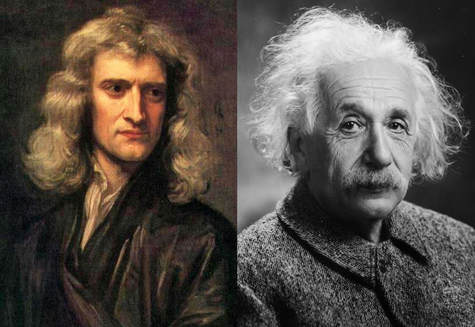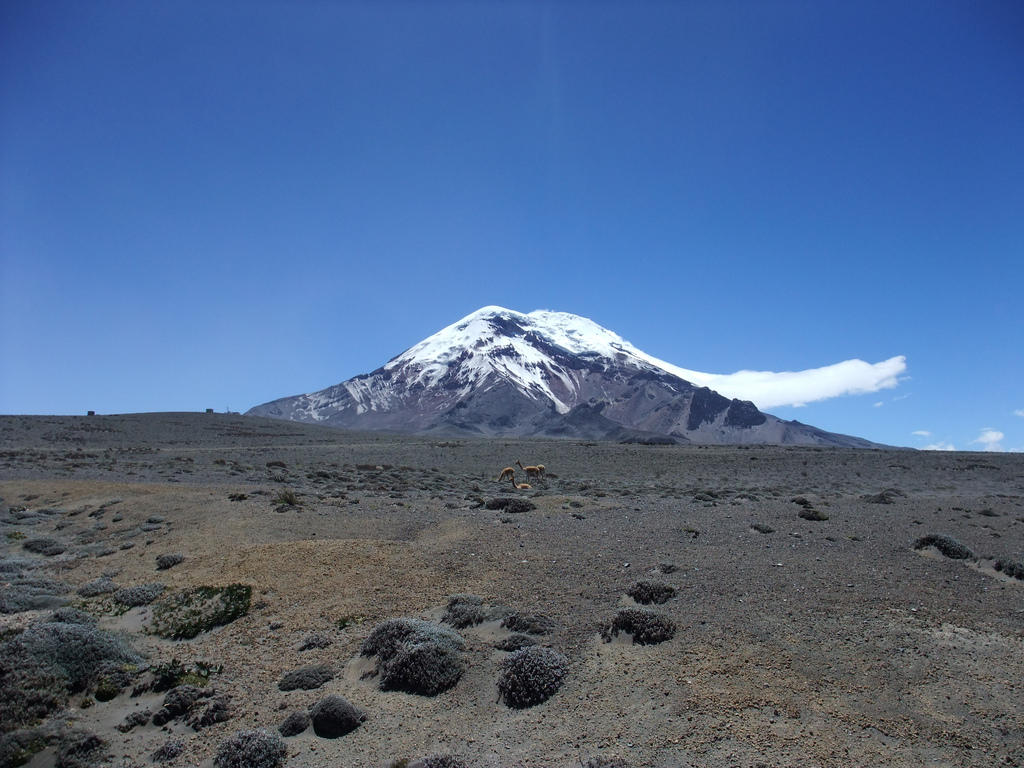|
The image below is a picture of the tallest mountain in the world. Do you know which is it? If you answered Mount Everest you are correct. This mountain is over 29,029 feet high above sea level and has a lot of name recognition. But let me ask the above question in a different way. When measured from the center of the Earth, which is the tallest mountain in the world? Or alternatively, the summit of which mountain is closest to outer space? Surprisingly the answer is not “Everest” but rather the mountain in the picture below. Do you know its name? This is a volcano in Ecuador called Chimborazo and it is 20, 564 feet tall when measured from sea level; an altitude way below that of Everest. However, when measured from the center of the Earth, Chimborazo is 1-2 miles taller than Everest and therefore its summit is also closer to outer space. In fact, when the height of a mountain is measured in this manner, Everest is not even in the list of the 20 highest mountains! How can this be? We need to remember that our experience can fool us. What can be more natural than to measure the height of a mountain from sea level to its summit? And the summit of the mountain thus found to be the highest must also be the closest point in the world to outer space, right? If we were living in a flat Earth or on a planet that does not rotate, that would indeed be the case, but the Earth is not a perfect sphere. Due to the Earth’s rotation, the land and the sea around the equator bulge outward. Someone standing at sea level on the Earth’s poles is about 13 miles closer to the center of the Earth than someone standing at sea level on the equator. Because Chimborazo is located 1 degree south of the equator, it sits on top of this bulge, whereas Everest which is 28 degrees north of the equator is closer to the Earth’s center. Considering this, one interesting question is: what about the death zone? The death zone is found in high mountains above an elevation of 26,000 feet above sea level. At this altitude the abundance of oxygen is only 1/3 of that found at sea level, and the bodies of most people are incapable of adapting effectively. The death zone is one of the reasons Everest is so hard to climb, and also why the route to the top in this area of the mountain is littered with the bodies of dead climbers. One would expect that if the summit of Chimborazo is closer to outer space than the summit of Everest, then it should also have a death zone. As it turns out this is not the case because the Earth’s atmosphere also bulges at the equator. As a result of this, the summit of Chimborazo is safely below the death zone and, unlike what happens in Everest, the bodies of most people can function in the thin atmosphere of the summit if allowed the time for adaptation to high altitudes. The foregoing illustrates the effect that small differences can have on some seemingly conventional measurements when these differences are taken into account over planetary scales. In terms of distance, the 13 miles that our planet bulges around the equator represents but a tiny fraction of the 3,959 miles comprising the Earth’s radius, and yet, this is enough to make the summit of Chimborazo the highest point on our planet! Everest from base camp Photo credit: Rupert Taylor-Price / Foter.com / CC BY Chimborazo Photo credit: apgwhite / Foter.com / CC BY-NC-ND
0 Comments
 The scientific consensus has been getting a bad rap lately. Some people argue that whether science is right or not about an issue is not decided by majority vote. Rather, it is claimed, it only takes one scientist to be right to decide whether the science regarding an issue is true or not. Those that make this argument then go on to provide a list of scientists that went against the consensus and prevailed. The people making these argument then proudly proclaim that in science there is no such thing as consensus, that science does not require a consensus, and if there is a consensus, then it isn’t science! Let’s try to understand a few things about the scientific consensus.
A scientific consensus is not reached when scientists get together and “vote”. A scientific consensus, unlike the use of this word in other fields such as politics, does not involve a compromise. Also the word consensus is sometimes used to denote the current state of a field as in “the current consensus”. In a new field of study the term “scientific consensus” really means “the current opinion” and it is understood that such opinion is very likely to be overturned in the future. This is not the meaning of consensus that better serves science in the public sphere when dealing with topics like climate change or evolution. The meaning of scientific consensus that we should seek is that consensus attained in a field of science that is backed by a fully developed scientific theory. A field of science that has not generated a fully developed scientific theory is incapable of generating a true scientific consensus. The reason this is the case is because a fully developed scientific theory has grasped important aspects of reality in its formulation and is likely to have a high degree of completeness. How is such a theory developed? When a field of study is in its early stages, scientists from several countries, ethnic backgrounds, beliefs, political persuasions, etc. begin tackling a problem. All these scientists bring their intellect and life experience to bear on answering the questions being investigated. Initially there is a multiplicity of possible answers, there are uncertainties, deficiencies and limitations in the methodologies, and there is confusion. Many scientists go down blind alleys only to find they have wasted their time on a wrong approach and have to turn back. Some explanations emerge that seem to be better than others. Methodologies are improved. Hypotheses are refined. Exceptions are explained. Scientists from other areas enter the field and bring new tools and ideas (a very important development). The research performed in these other fields is found to be complementary to the research in the emerging field. Eventually as the field matures scientists from different laboratories using different methodologies begin obtaining the same results and elaborate models that they use to make predictions (another very important development). Some predictions are not fulfilled and the models that generated them fall by the wayside and are replaced by new models that are more accurate at explaining the data and making new predictions. Eventually the field coalesces around a theory. The theory is used to generate practical applications and to explain observations in other areas of science. A theory developed through the process described above is not an ephemeral construct that can be overturned at any time. The very technology that we use in our everyday lives depends on hundreds of solid scientific theories that have never been disproven. Many people who do not understand the nature of scientific truth confuse the overturning of a scientific theory with its refinement. This is because there is the erroneous notion that scientific theories should explain everything, and this is not the case. A scientific theory only has to answer the most important questions raised by scientists. Thus, when a fully developed scientific theory is produced in a field of study this means that scientists have stopped arguing with each other about the salient points addressed by the theory. In other words, they have reached a consensus. This is the true meaning of a scientific consensus. Of course, the fact that there is a consensus doesn’t mean that everything has been settled. Scientists that agree with evolution are still debating how evolution happens. Scientists that agree with climate change are still debating its extent and mechanisms. Nevertheless, a consensus does mean that the major overreaching question in the field has been answered to the satisfaction of the vast majority of the scientists involved in the research. The consensus can, in principle, be modified if the underlying theory that backs the consensus is found to be incomplete, but this is only true if the refinements to the theory in the form of new observations, new data, or new interpretations of old data or old observations, significantly modify those parts of the theory that are vital for the consensus. In the case of a fully developed scientific theory this is no easy task, and the burden of proof is on those who seek to modify the theory. Some people claim that this promotes a herd mentality that leads to dissenting scientists being penalized and those that are compliant being rewarded resulting in the discouragement of innovation. However, what has to be understood is that science is a very conservative enterprise that sets a very high bar for those seeking to challenge what is considered established knowledge. If you are going against the prevailing theory, you’d better have very good evidence. This is not the product of a herd mentality or a way to discourage innovation: it is a way of protecting established science against error. In the public debate, when you hear that a consensus has been reached in a particular field of science, you need to ask about the nature of the underlying theory that backs it. If the theory fulfils the requirements of a fully developed scientific theory, then the consensus is good. A consensus is only as good as the theory that supports it. However, suggesting that there is no such thing as a scientific consensus or that it is irrelevant is nothing more than a strategy to delegitimize science. It has been used in the past by entities such as the cigarette lobby, and it is being used today by creationists, climate change deniers, and other groups that seek to further their anti-science agendas. Image by Nick Youngson used here under an Attribution-ShareAlike 3.0 Unported (CC BY-SA 3.0) license. Some scientific theories that are in the way of religious, political, and corporate interests have been getting a bad rap. These theories are claimed to be false by their foes. So for example, creationist claim that evolution is false, climate change deniers claim that global warming is false, and so on. In fact, many people seem to imply that theories are ephemeral, and to buttress their claim they offer a list of theories that have been proven “false”. Why should we rely on a scientific theory to affect public policy today if it can be shown to be false tomorrow? In addressing this issue there are several things we have to consider. Before we begin, we need to make the clarification that the word “theory” in the popular parlance can be a synonym for a guess or a very preliminary explanation. In science, a theory is a vastly more stable form of knowledge. In fact, if the theory is sufficiently developed, it in itself can become a fact. So what are the characteristics of a sufficiently developed theory? They are: 1) It explains the existing observations and experimental results. 2) It has generated predictions that have been found to be true. 3) It has generated practical applications that work. 4) Results from other scientific disciplines corroborate the theory and the theory corroborates results in other scientific disciplines. Please read the list above again carefully. Don’t you think that when a theory fulfils these characteristics we can say with confidence that it has clearly grasped important aspects of the realities it’s trying to explain? But, you may ask, what if a genius like an Einstein comes along and thinks up a new interpretation for everything the theory explains and predicts, and expands it into a different theory to explain new things? Can’t we say then the theory was proven false?  Well, let’s consider what Einstein did. He reinterpreted Newton’s laws of gravitation and motion, and came up with explanations for phenomena the Newtonian interpretations could not explain. Einstein thus relegated Newton’s laws to particular cases where velocities are much lower than that of the speed of light or when very strong gravitational fields are not involved. But here is the thing: the speeds at which planets, rockets, space probes, and objects in everyday life move, and their behavior in the gravitational fields that they encounter most of the time, can be described with a satisfactory level of accuracy by Newton’s laws. The existence of a planet (Neptune) and the return of a comet (Halley’s Comet) were predicted using Newton’s laws. The life of astronauts and the integrity of multimillion dollar space probes depend on the veracity of the calculations employing Newton’s Laws. Is it fair to say that Einstein proved Newton’s theories were false? Of course not! Einstein showed Newton’s theories were incomplete, and this is what the public has to understand when discussing scientific theories. Sufficiently developed scientific theories cannot be false, they can only be incomplete. When assessing scientific theories, it is counterproductive to talk in terms of true or false. What has to be discussed is whether a theory has been formulated at a high enough level of detail, in other words, whether the theory is complete enough. We don’t need theories to be 100% true. They can’t be (nothing can), and they don’t have to be. We only need the theory to be complete enough to be useful for society. Finally, it must be pointed out that the vast majority of scientific theories are not “big name” theories such as the theory of evolution or global warming. There are hundreds of scientific fields and subfields that have given rise to thousands of theories most of which are boring, highly technical, and devoid of importance to the “culture wars”. Therefore they do not make the news, and non-scientists are not even aware of them. Most of these theories have never been overturned, and in fact form the basis of modern science leading to tens of thousands of practical applications and policies. If these theories were not sufficiently complete representations of reality, modern life would not be possible! So next time you are pondering the worthiness of a scientific theory, remember, it's all in the completeness. The figure is a collage of a copy of a painting of Isaac Newton by Sir Godfrey Kneller (1689), which is in the public domain, and a photograph of Albert Einstein by Orren Jack Turner obtained from the Library of Congress, which is also in the public domain because it was published in the United States between 1923 and 1963 and the copyright was not renewed. 2/7/2018 Is the Earth round? Avoiding The Absolute Truth to Find the Practical Truth: the Devil is in the Level of DetailRead NowMost people hold a “binary” notion of the truth. For them things can either be true or false, because that which is false cannot be true, and that which is true cannot be false. We will call this notion the “absolute truth”. I want to argue that this absolute truth notion is unsatisfactory and impractical at addressing the worthiness of scientific theories. For this purpose I will use an example. Consider the idea that the Earth is flat. For people in antiquity living in a flat place like the plains or a desert it probably made sense to think this, but eventually the ancients figured out that the Earth was not flat. The Earth is round and we know that for a fact nowadays. So, the Earth is flat: false, the Earth is round: true; right? Actually, the Earth is not round! As Isaac Newton proposed and was later found to be correct, the Earth, due to its rotation, is an “oblate spheroid”, which means it is flater at the poles and bulging at the equator (the distance from the Earth’s center to sea level is 13 miles longer at the equator). OK, so, the Earth is round: false, the Earth is an oblate spheroid: true, right? Well, not quite. The Earth is an oblate spheroid, but the southern hemisphere is wider than the northern hemisphere giving the Earth a bit of a pear shape. Fine, so the Earth is an oblate spheroid: false, the Earth is a pear-shaped, oblate spheroid: true, right? Actually, even this is false! The Earth’s mass is not distributed evenly across the planet, and the greater the mass, the greater the gravitational force, which leads to the creations of bumps in the Earth’s crust. Additionally these bumps change overtime due to the movement of continental plates, the changing weight of the oceans, lakes, ice masses, and atmosphere, and the gravitational pull of the sun and the moon. All of these processes can deform the Earth’s crust by the order of millimeters to a few dozen centimeters daily and by much larger amounts over geologic times. So the Earth is a bumpy, shapeshifting, pear-shaped, oblate spheroid? Yes. Wahoo, we did it! At last we have the absolute truth! The Earth is an pear-shaped, oblate spheroid: false, the Earth is a bumpy, shapeshifting, pear-shaped, oblate spheroid: true, right? At this point you are probably thinking: seriously, are you kidding?  This is the problem with the absolute truth notion: it ignores the level of detail that is required for adequately describing physical phenomena. The level of detail that is required from a description of the shape of the Earth will vary depending on what you are intending to use it for. For surveyors determining distances in small patches of the Earth’s surface, a flat Earth model is perfectly suitable, as the error in the measurements is negligible. For people dealing with time zones, the round Earth description is perfectly adequate. On the other hand, satellite orbits can be affected by small deviations of the Earth’s crust from a perfect sphere, so people following satellites must take into account the oblate spheroid and pear deformities of the Earth. Similarly, people running particle accelerators must understand that the Earth is constantly shifting its shape so they can keep track of very small deformities in the Earth’s crust that arise daily and may mess up their measurements. The vast majority of people would accept that the claim that the Earth is flat is false (low level of detail). On the other hand, most people would consider further refinements to the round Earth claim such as the oblate spheroid; pear-shaped, oblate spheroid; or bumpy, shapeshifting, per-shaped, oblate spheroid to be a needless amount of precision (too high a level of detail), and rightly so. The type of deviations from a spherical shape that these highly detailed models of the Earth deal with is at most about a dozen miles. If you take into account that the Earth’s radius is 3,959 miles, we are talking about a difference of 0.3%. By this token the Earth’s crust, despite its mountains and sea trenches, is very smooth. So for the use that most of us make of the information regarding the shape of the Earth, a round Earth model is an acceptable level of detail. Depending on what you are trying to explain or achieve, trying to find the absolute truth may be not only impossible or unnecessary, but also cumbersome. So we come to the paradoxical realization that seeking the absolute truth may actually hinder or prevent our discovery of the practical truth! When scientists seek the truth regarding physical phenomena, what they have in mind is the practical truth which is a truth defined at a sufficiently high level of detail to explain the phenomena they are studying and derive predictions and useful applications. Later on other scientists may seek to explain things at a higher level of detail to address more complex questions that a lower detailed truth can’t answer satisfactorily, and so on. What the public has to understand is that a scientific theory does not have to explain everything to be considered “true”. It just has to explain the relevant phenomena at a sufficiently high level of detail to generate accurate predictions and useful applications. The debate should not be about whether a given theory is true or false, but rather about whether a theory has been formulated at a sufficiently high level of detail for society to benefit from it. The image from NASA is in the public domain. |
Details
Categories
All
Archives
June 2024
|


 RSS Feed
RSS Feed